In the year 2000, well-known designer Reiner Knizia released The Lord of the Rings, what was arguably the first “cooperative” board game, a game in which players all team up together to beat “the game” instead of attempting to defeat each other. The cooperative genre has gone on to spawn many popular and well-respected titles; some are “light” like The Mind, others are much heavier like Mage Knight or Spirit Island, and still others are smash hits like the Pandemic series of games. In any case, cooperative games encourage us to work together – teaming up with like-minded people to conquer the trials set in front of you.
Ravine, from Stellar Factory, joins this distinguished list and brings a bit of light-hearted fun to the table. Keep reading to find out how to play Ravine or jump to the end to hear my thoughts about the game.
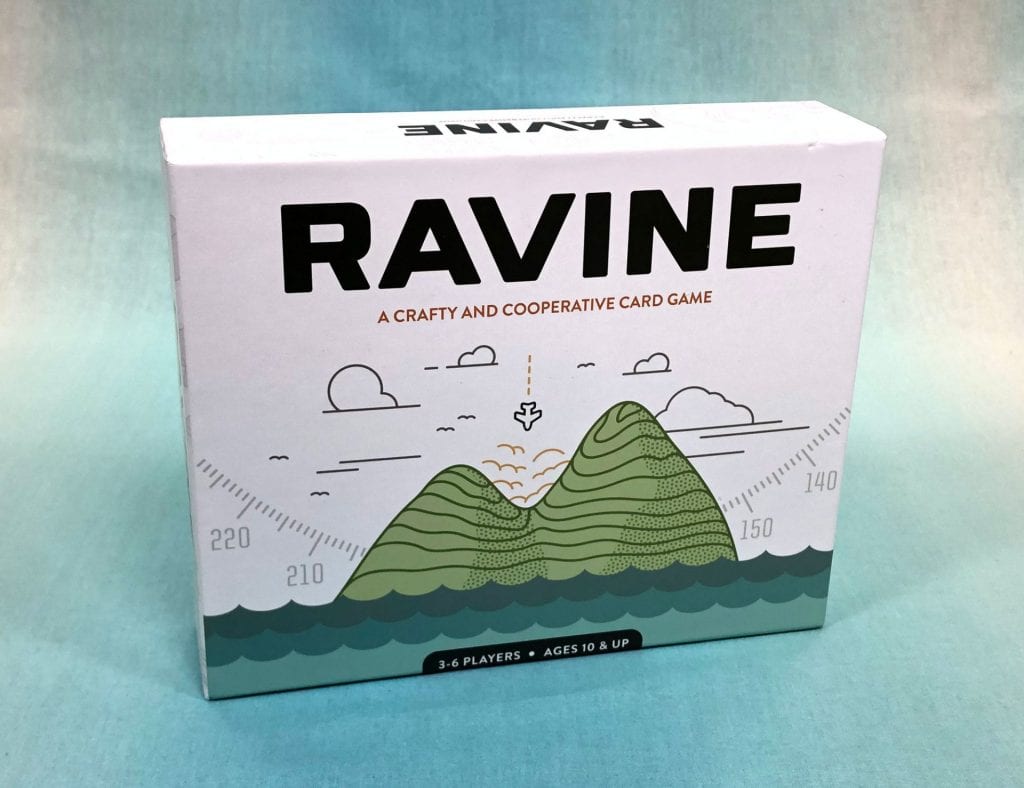
Wherein Wilson is Nowhere to be Found
In Ravine, your airplane has crash-landed onto a deserted island. You and the other players must survive on the island until you’re rescued; foraging for supplies during the day, braving the dangerous and unpredictable nights, all the while trying to avoid descending into madness or death. You can build fire, make spears and shelters, fight off wild animals or even potentially other players (more on that later).
Setup for the game is easy. Shuffle each of the decks individually (Forage, Night, Madness, and Wreckage). Deal out a number of Night cards based on the difficulty level you want; the Beginner level starts with 8 cards while the Difficult level starts at 16 cards and goes up from there. Shuffle the Rescue card into the bottom 3 cards of the Night deck.

Each player gets one Crafting Guide card that tells you how to combine some of the supplies you’ll find into useful items and a Wreckage card that provides benefits like a bottle of vodka (restores health), a newspaper (provides shelter from the weather), and a taser (protects you from animal or human attack). Players also begin with 6 double-sided heart tokens (one side “full”, the other side “empty”). To simulate potential injuries in the crash, three of your heart tokens are placed “full side” up, while the other three are cast onto the table randomly. You might wind up with 6 full hearts or only 3 if you’re really unlucky.
And make no mistake, luck plays a heavy role in this game.
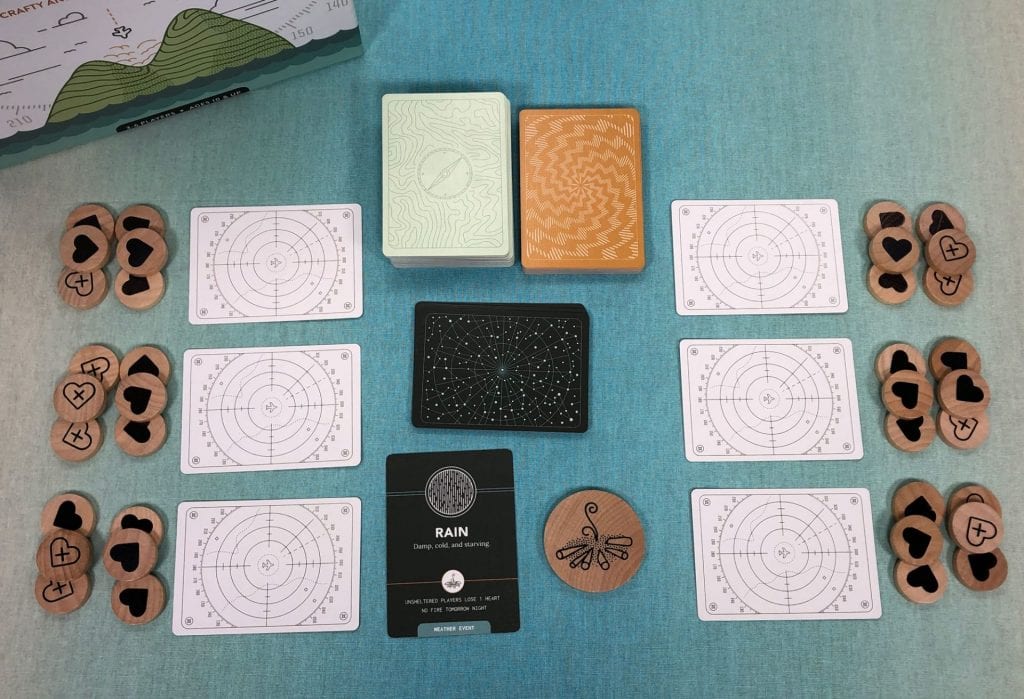
How to Play Ravine
Each round of Ravine is split up into four main phases that repeat until all players are either dead or rescued: Night, Health Check, Day (Forage), and Prepare.
Night – “I Had Power Over Nothing”
During the Night phase players flip over a single card from the Night deck, then respond to the indicated event. Possibilities include uneventful nights, discovering a cave, losing hearts because of survivor guilt or animal attacks, and weather events that can cause assorted effects. Many of the Night events can be cancelled out if you have a fire, so do your best to make one during the Prepare phase.
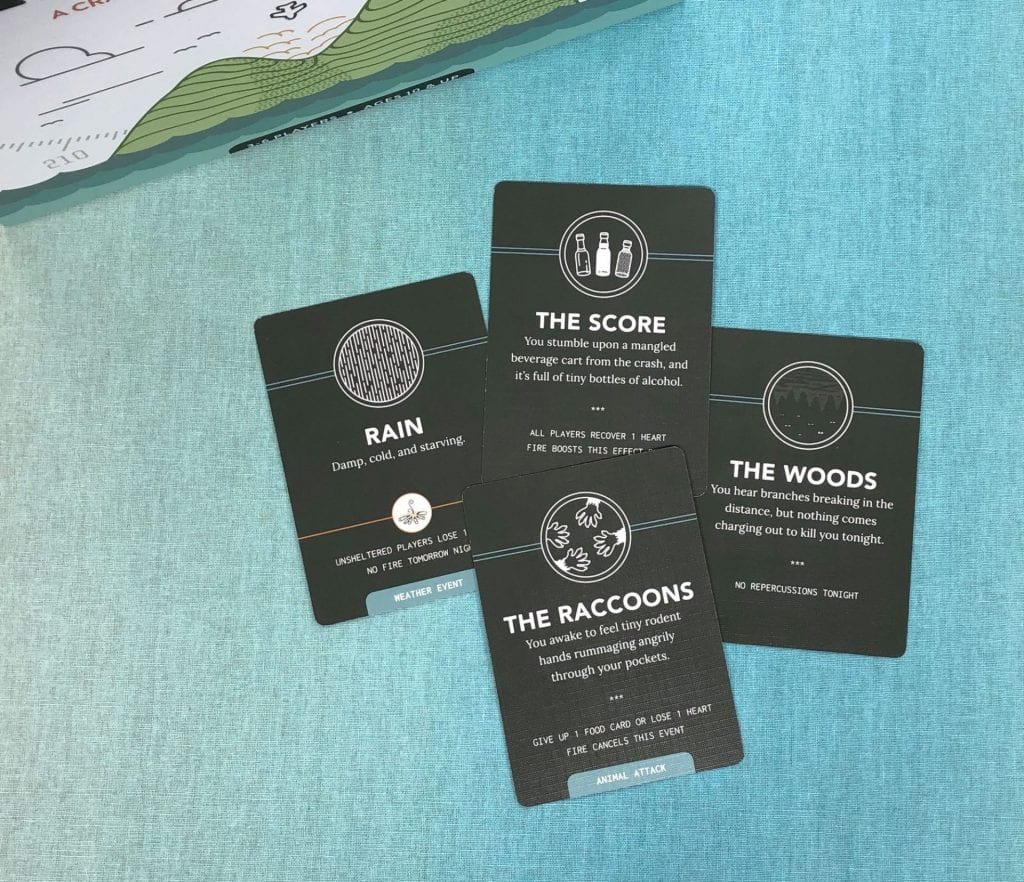
Health Check – “I Gotta Keep Breathing. Because Tomorrow the Sun Will Rise”
During the Health Check phase each player evaluates their remaining health. Any player who has only one heart must draw a Madness card and resolve its effect.
The Madness cards are where Ravine really reveals its silly side; they’re a mixed bag of bad, really bad, and zany. Some of them can be goofy like Call Me Captain (stand up, loudly declare that your name is Captain Cranberries, and refuse to speak unless players refer to you by that name) or Copycat (mimic the speech and actions of the player to your right). Some are frustrating like Throwing Fits (violently throw all of your cards, keep whatever lands face up), Sabotage (steal 3 Forage cards from the group and discard them), or Blind Rage (your eyes must remain closed until you regain a heart). Yet others can have deadly consequences like Showdown (challenge the player on your left to a thumb or arm wrestling contest – the losing player also loses a heart) or The Final Hunt (draw a card from the Forage deck, lose 1 heart if it isn’t a food card).
All Madness cards have a “recovery” section that indicates how players “complete” the card. It might be simply resolving the effect, regaining a heart, or in some cases “never”.

Day (Forage) – “Coconut Milk is a Natural Laxative”
After the Night and Health Check phases are completed players have the opportunity to Forage. To Forage players flip over up to 3 full hearts to their empty side. For each token flipped over players may draw 1 card from the Forage deck. Any player with a Basket may draw an additional Forage card.
After all players have drawn their Forage cards they’re revealed to the group. Players may keep their cards or share them with the rest of the players. For example the Rabbit card provides 3 hearts, which can be shared between up to 3 players. Forage cards are generally grouped by outright beneficial (Wild Parsnips, Currants, Pine Nuts or other food items that let you flip over heart tokens), potentially beneficial (Wood, Stone, or Fiber, all of which let you construct things), annoying (Mushrooms that can cause paralysis or Madness), to dangerous (Wasp Nest, Mushrooms that can cause you to lose all but 1 of your hearts, and other cards).

Prepare – “I Have Made Fire!”
During the Prepare phase players will divide up the food and use Wood, Stone, and Fiber to craft beneficial items like Fire, Spears, Baskets, or Shelters. Fire can stave off many of the Night card events so building a Fire should be an absolute priority. Spears allow one player to fight off an animal or human attack, Baskets allow players to collect extra Forage cards, and Shelters can prevent injury from weather events.
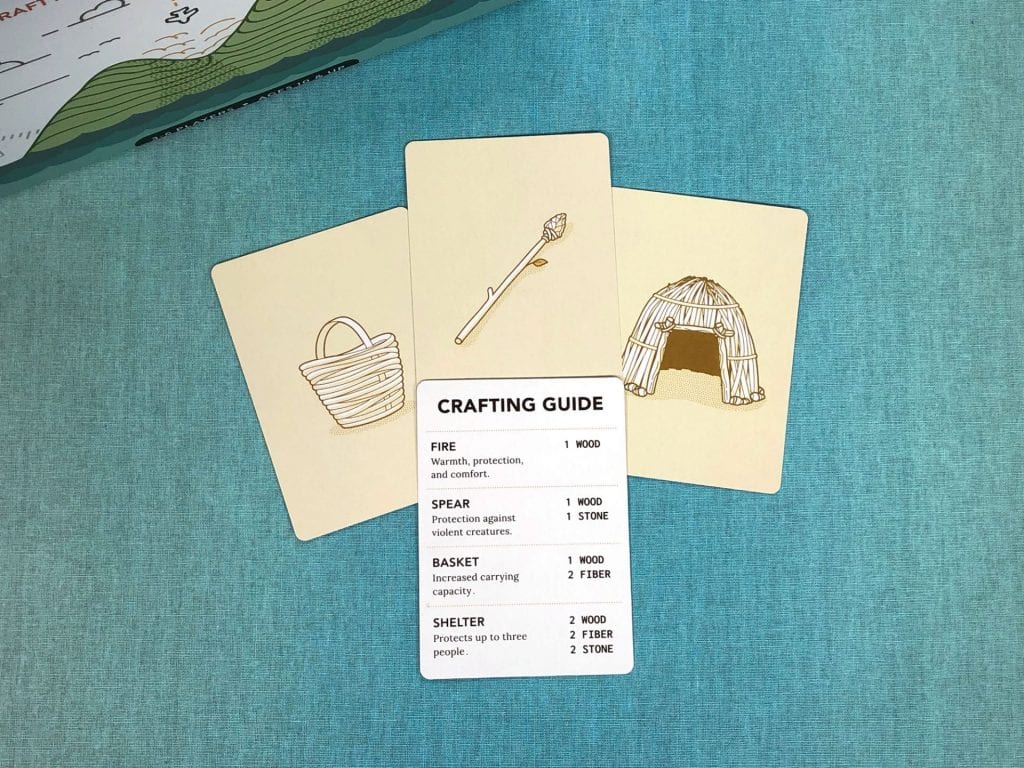
Rescue or Death
Repeat the 4 phases of the game until either the Rescue card is drawn from the Night deck or until all players have died. Whoever is still alive when the Rescue card is drawn makes it off the island and fields “lucrative offers for book deals, made-for-TV movies, and tabletop game adaptations of your harrowing experience.”
Final Thoughts on Ravine – “We Live and We Die by the Clock, That’s All We Have”
Flashback to November 2017 when Matthew Sisson launched the Ravine Kickstarter. In just 5 hours they were fully funded and would go on to raise over $315,000 USD to bring their vision to life. I decided against backing the Kickstarter for some unknown reason, but my family purchased this game for me this past Christmas.
And let me tell you that Ravine is excellent!
Cooperative games tend to be a bit of a crapshoot. Some of them are excellent (Forbidden Island, Zombie Kids Evolution, Spirit Island), some of them lend themselves to the “quarterbacking” phenomenon (where one player winds up dominating the game), and then some of are so challenging that it’s become a badge of honor to beat them (Ghost Stories or The Grizzled).
Then there’s another segment of cooperative games, ones which are more about the experience: games like The Mind, Hanabi, and Ravine. Unlike more involved games, these titles allow each player to fully control their turn, while still working with the other players to accomplish the end goal.
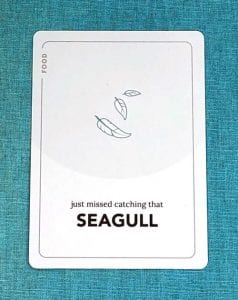 Ravine might involve a serious subject – plane crashes – but the designers really took a tongue-in-cheek approach to the material. Amusing anecdotes, clever flavor text, and cards that are guaranteed to make you laugh out loud. For example, I Foraged one time and the only card I got was a “Just missed catching that Seagull” with zero hearts. After I read it, the table busted out laughing.
Ravine might involve a serious subject – plane crashes – but the designers really took a tongue-in-cheek approach to the material. Amusing anecdotes, clever flavor text, and cards that are guaranteed to make you laugh out loud. For example, I Foraged one time and the only card I got was a “Just missed catching that Seagull” with zero hearts. After I read it, the table busted out laughing.
In general games take about 15-20 minutes or so with my family (my wife and I, plus 4 kids: ages 15, 12, 10, and 8). You might take more time if your group is particularly chatty or can’t stop laughing over some of the Madness cards.
The artwork is sparse but superbly illustrated, with a style reminiscent of airline safety cards (appropriate right?). The heart tokens are thick silk-screened solid wood, a surprising, but welcome, addition to the game.

The rulebook is clearly laid out and split into the various phases of the game. Although it might have been nice to include a few examples for clarity, we didn’t have much trouble understanding the cards.
The only time we had issues with the game were when multiple people all had a single heart. We weren’t able to send enough people out to Forage and the supplies that were brought back didn’t help us increase our heart levels. That meant for a round or two we were stuck in a holding pattern, not able to gain enough health to improve our lot in the game. While this is absolutely thematic, it doesn’t make for fun gameplay if it were to happen often. Thankfully the other parts of the game more than make up for this potential problem.
I’m thrilled to have gotten Ravine, enough so that I immediately purchased The Spirits Expansion, which increases the player count to 9 and adds new Spirit related Forage, Night, Madness, and Wreckage cards with some really clever new effects. A note that the Spirit cards are intentionally misprinted with text and illustrations that look “glitchy”. They’re easily readable, but look different enough that multiple buyers on Amazon complained about the “print quality” before finding out that it was intentional.

If you’re looking for a light-hearted card game that’s fun for the whole family then you can’t go wrong with Ravine.


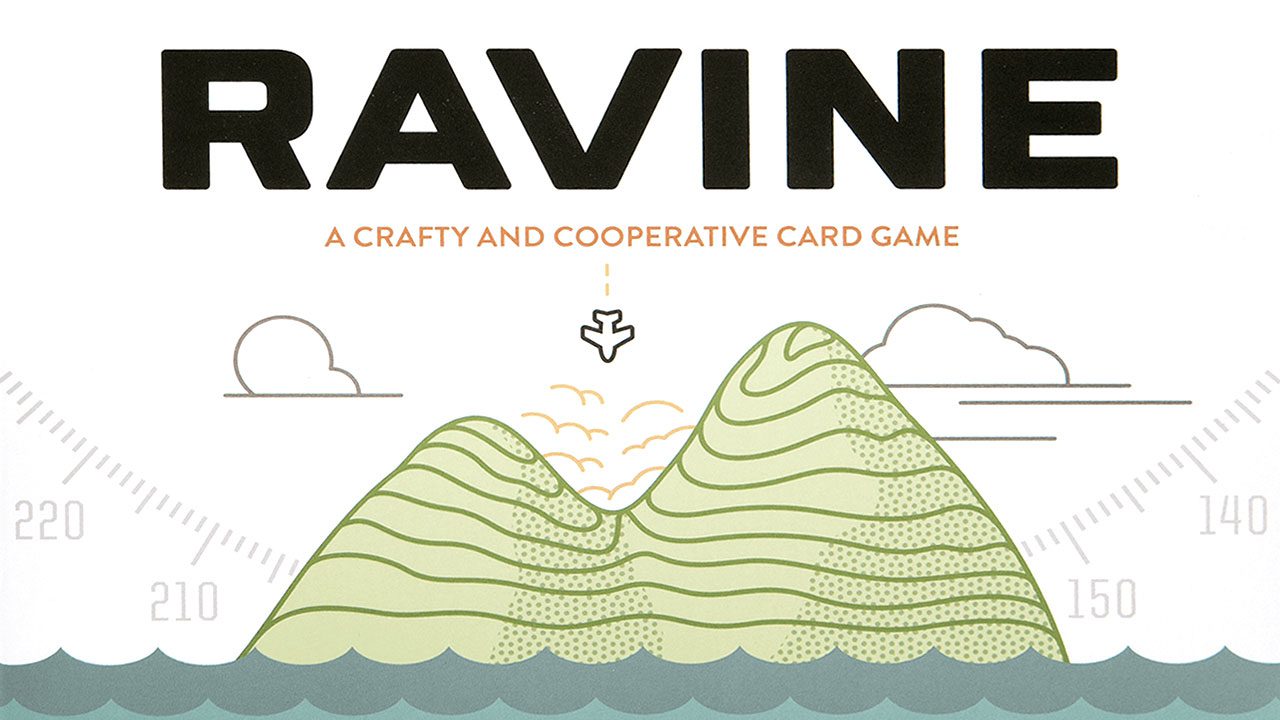



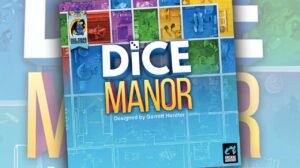





Sounds like a fun time! My wife loves cooperative games, so…